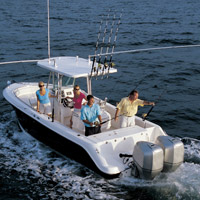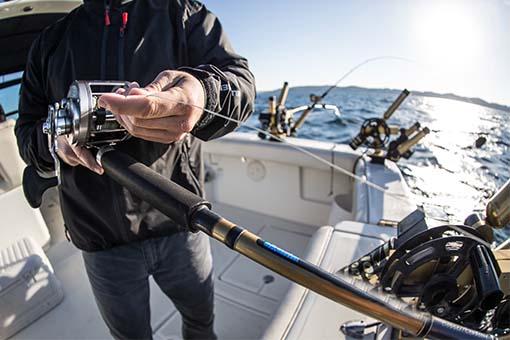Fishing tackle is used to get your bait or lure to the fish. You don’t need a lot of equipment to begin fishing. In fact, it’s a good idea to begin with basic, simple tackle. So here are the basics. You can try more difficult tackle after you’ve mastered some basic skills.
Fishing Pole and Line
The simplest fishing tackle is a pole; however, for some types of fishing, even a soda can with fishing line wrapped around it can be used!
The pole can be made of cane, bamboo or a straight piece of tree branch. You do not use a reel with a pole. Cut a piece of fishing line as long as the pole. Tie the line to the tip of the pole and a hook to the other end of the line. A small sinker, called a "split shot," is squeezed onto the line above the hook. The sinker makes it easier to swing the bait out into the water and keeps the bait under the surface. You may also want to use a bobber or float. By moving the bobber up or down the line, you can change the depth of your bait in the water. With a pole and line you can fish the area near the bank, where many fish often live.
Fishing Rods and Reels
Other types of fishing tackle use reels to store large amounts of line. They let you cast a bait or lure farther. They also help you retrieve lures correctly, fish in deeper water, and battle larger fish more easily. There are four kinds of reels: spincast, spinning, baitcast, and fly. Each kind uses a different type of rod.
Spincasting
Spincasting tackle is ideal for beginning anglers because it works well and is easy to use. A spincasting rod has small line guides and a straight handle. Spincasting tackle is often used while fishing for bluegill, crappie and other panfish. The spincasting reel mounts on top of the rod’s handle. The fishing line comes out of a small hole in a cover on the front of the reel.
Casting With a Spincasting Outfit
To cast, grip the pistol grip with one hand. If you’re right-handed, turn the rod sideways so the reel handle points straight up; if you’re left-handed, point the reel handle straight down. Push the reel’s thumb button down and hold it down.
Face your target area and turn your body at a slight angle. The arm holding the rod should be closest to your target. Aim the rod tip toward the target-about level with your eyes.
Swiftly and smoothly, bend your casting arm at the elbow, raising your casting forearm until your hands reach eye level. When the rod is almost straight up, it will be bent back by the weight of the practice plug. As the rod bends, move your forearm forward with just a slight wrist movement. When the rod reaches eye level, release the thumb button and let the line travel freely.
If the plug lands close in front of you, you released the thumb button too late. If the plug went more or less straight up, you released the button too soon.
Learning how to use a spincasting rod and reel isn’t too hard, but it does take practice. Buy a practice-casting plug. This is a rubber or plastic weight without hooks. Then, tie it to the end of the line. Find a spot where you can practice safely. Put a target on the ground about 25 feet away. Practice casting until you can consistently hit the target with your casting plug. Being able to hit a target is much more important than being able to cast a long distance!
Spinning Rods
Spinning rods have a straight handle with large line guides that are on the bottom of the rod. A spinning reel is often called an "open-face" reel because the spool of fishing line isn’t covered. The reel mounts under the handle. Spinning rods and reels allow for more line to be quickly peeled off the reel, allowing for casting longer distances.
Learning how to use a spinning outfit may take more practice than spincasting. Casting with a spinning outfit is very similar to using spincasting equipment. However, at the beginning you grasp the spinning rod’s handle, placing the reel "stem" between your second and third fingers. Your thumb should be on top of the handle and your forefinger extended to touch the spool cover. With your other hand, rotate the reel spool until the line roller is directly beneath your extended forefinger. Pick up the line in front of the roller with your forefinger and open, or cock, the reel’s bail with your other hand. (Some reels have a lever so you can grasp the line and open the bail in one motion.)
After you have accomplished this procedure, casting is very similar to that for spincasting except that when the rod reaches your eye level as you are casting, you release the line from your forefinger rather than releasing the thumb button. Again, if the plug lands close in front of you, your forefinger released the line too late. If the plug went more or less straight up, you released your forefinger too soon.
To prepare for practice follow the same steps as for spincasting.
Baitcasting
A baitcasting rod can have either a pistol-type grip or a straight handle. As in spincasting, the casting reel and line guides are mounted on top of the rod. Unlike the other two types of reels, the casting reel’s line spool turns as you cast and can snarl the line if it is not controlled properly. Learning to control this spool makes casting tackle harder for most people to learn, and is considered a skill for advanced anglers.
Drag
All reels have an adjustment called a drag that controls how easily the line is pulled off the reel. When set correctly, the drag lets a larger fish pull some line from the reel until the fish becomes tired. Follow the directions that come with your reel to set the drag correctly.
Flyfishing Tackle
Flyfishing tackle is different from all of the other types. In flyfishing, you are casting the line that carries the "fly." With other fishing tackle the weight of a bait or lure pulls line from a reel. In flyfishing, the reel is only used to store the line.
Flycasting is usually the most difficult to learn. However, with proper instruction, anyone can learn how.
Saltwater Tackle
Saltwater tackle requires special equipment because saltwater will corrode any aluminum, steel or iron parts. The metal parts of saltwater tackle usually are made of stainless steel or nickel chrome. Saltwater tackle ranges from the ultra light equipment used in inshore fishing to the extremely large and heavy tackle for deep-sea fishing.
Ice Fishing Tackle
Ice fishing is a very specialized sport. One to three-foot rods are most often used. Simple reels are used to hold the line. Ice fishing can also be done with tip-ups. Tip-ups fit over a hole in the ice. When a fish hits, it releases a lever. This causes a flag to tip up, alerting the angler.
Submitted by the Future Fisherman’s Foundation www.futurefisherman.org


